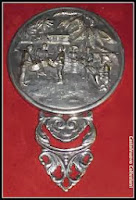Today we are so used to seeing images of ourselves in mirrors and photographs it is difficult to imagine a world without reflections. But just try.
THE PEGSDON MIRROR - A VEHICLE OF THE SOUL?
Imagine a world in which you don’t really know what you look like, where the only way to see your own reflection is in a pool of still water. Using a mirror like the one found in Pegsdon, Bedfordshire, and featured in the ITV series Britain's Secret Treasures, meant that for the first time Iron Age people, about 2,500 years ago, were no longer reliant on others to tell them how they looked.
Today the mirror is part of our everyday routine but cheap, mass-produced mirrors are a product of the past few centuries. Before that mirrors were rare and expensive social objects allowing people to monitor physical appearance and apply cosmetics. Their reflective surfaces were also perceived in different ways, taking on religious, medical and artistic functions. For example, a mirror allows you to see behind as well as in front, extending the realms of ‘normal’ human physical experience.
In the Greco-Roman world looking backwards was linked to looking into the future or the past and the reflection from a mirror was used in divination – attempts to predict events, or peoples fate. Mirrors were lowered into water and the reflections ‘read’. Alternatively mirrors were used to evoke light or the vehicle of the soul.
It is impossible to determine the true significance of the Pegsdon mirror. The fact that it is so beautifully made and decorated and that it was carefully placed in someone’s grave indicates it was a valued and treasured object. The association between mirrors and cosmetic sets in other Iron Age graves links them to the main function of mirrors today, as a means to monitor appearance.
However, there is no reason why mirrors did not also have other kinds of significance in Iron Age society. For example, even today we still see breaking a mirror as 7 years of bad luck.
by
Jody Joy, curator, British Museum,
taken from British Museum blog:
http://blog.britishmuseum.org/


.jpg)
.jpg)


